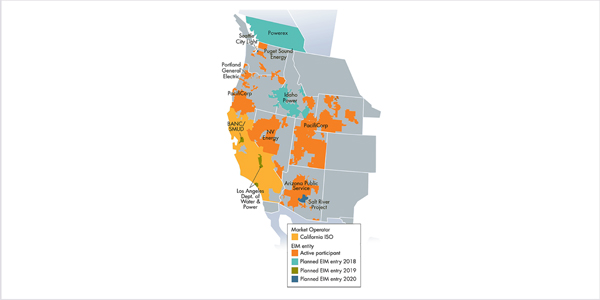By Jason Fordney
The Western Energy Imbalance Market (EIM) expanded its footprint and ambitions in 2017 while new suitors lined up to compete with CAISO as the vehicle for a Western RTO.

Current and pending members of CAISO’s Western EIM | CAISO
Idaho, Washington, Arizona, Nevada and Canadian provinces are considering how to access regional markets while protecting the financial health of their resources and keeping costs reasonable for consumers.
The EIM has been recognized as a success story. The increased efficiency of regional dispatch and having more offramps for generation are attractive not only for renewables, but also for coal, hydro and natural gas generation in the market’s balancing authorities.
Five utilities have joined the EIM since its inception in 2014, including Portland General Electric in 2017. Six others have announced plans to join: Idaho Power and Powerex in 2018; Los Angeles Department of Power & Water and the Sacramento Municipal Utilities District in 2019; and the Salt River Project and Seattle City Light slated for 2020. In December, CAISO announced plans to expand its EIM offerings with a day-ahead market. (See CAISO Plan Extends Day-Ahead Market to EIM.)
Mountain West, Peak Reliability
But CAISO faces competition in its bid to expand into a RTO.
Last January, Mountain West Transmission Group said it would begin talks to join SPP. Mountain West, a partnership consisting of seven different transmission-owning entities within the Western Interconnection, covers most of Colorado and Wyoming with smaller areas of Arizona, Montana, New Mexico and Utah. The potential move has been of keen interest to regulators in the affected states. (See Colo. Regulators Talk Governance with SPP, Mountain West.)
In December, reliability coordinator Peak Reliability announced it would work with a unit of PJM to develop new market structures for the West. “We are continuing our review with PJM Connext of potential reliability services and markets in the West and our outreach with western industry leaders and stakeholders,” spokeswoman Rachel Sherrard told RTO Insider last week. (See PJM Unit to Help Develop Western Markets.)
Legislation Stalls
The California State Legislature ended its 2017 session in September after failing to pass bills that would have advanced CAISO’s regionalization efforts.
AB 726 and AB 813, which were returned to the Senate Rules Committee, would have repealed a section of the Clean Energy and Pollution Reduction Act of 2015 governing the transformation of the ISO into an RTO and created a Commission on Regional Grid Transformation. The bills would authorize the transformation if the CAISO Board of Governors and the commission took certain actions by the end of 2018.
Lawmakers say they will reconsider the legislation after they return to Sacramento this month. The debate over regionalization in California involves issues of state control over resources and policy, and highlights concerns over energy costs and the influence of labor groups worried over exporting energy jobs.
The legislature also is under heavy pressure to pass zero-carbon legislation that also fell short in 2017. California’s policies to phase out fossil fuels in favor of renewables and new technologies have raised cost concerns and forced changes to long-standing engineering approaches to accommodate more variable renewable output and the complexities of smaller, distributed resources. (See CAISO Regionalization, 100% Clean Energy Bills Fizzle.)

Governor Jerry Brown
Gov. Jerry Brown has taken a defiant stance against President Trump’s environmental policies, recently traveling internationally to evangelize for fighting climate change.
Brown attributed the recent wildfire devastation in California to climate change, saying the state’s fire season is now months rather than weeks. Fire investigators are focused on utility infrastructure as a possible cause, setting up complicated and contentious proceedings at the Public Utilities Commission over penalties and cost recovery. (See CPUC Targets Wildfires, Multifamily Solar, RMRs.)
During an interview on “60 Minutes,” Brown discussed Trump and climate change in religious terms. “I don’t think President Trump has the fear of the Lord, the fear of the wrath of God, which leads one to more humility,” he said. “And this is such a reckless disregard for the truth and for the existential consequences that can be unleashed.”
This summer, Brown signed a bill that extended the state’s carbon cap-and-trade program until 2030. (See California Lawmakers Extend Cap-and-Trade.) The program will help the state meet its goal of reducing GHG emissions to 40% below 1990 levels by 2030.
Other CAISO, PUC Initiatives
In addition to its regionalization efforts, CAISO has more than a dozen other initiatives underway, with day-ahead market enhancements and resource adequacy at the top of the list in its 2018 roadmap. The conflict between state resource adequacy programs and CAISO’s reliability management are another priority because of the increasing number of reliability-must-run agreements.
The growth of community choice aggregators led the PUC to propose that they be subject to the same resource adequacy requirements as electric utilities. (See California Proposes Resource Adequacy Obligations for CCAs.)
In December, the board of the Western Electricity Coordinating Council, the NERC-designated Regional Entity for 14 Western U.S. states, Alberta, British Columbia and a small portion of Baja California, Mexico, endorsed a new three-year operating plan. The plan continues the transformation that began in 2014, when Peak Reliability split off from WECC as the Reliability Coordinator for the Western Interconnection, except Alberta. (See WECC Finding New Direction in Old Mission.)



